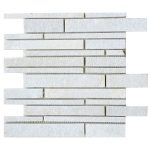The Evolution and Advantages of Industrial Cultured Stone
Introduction
Industrial cultured stone, also known as manufactured stone or faux stone, has revolutionized the construction and design industry in recent years. This versatile building material has gained popularity for its aesthetic appeal, durability, and cost-effectiveness. In this article, we will explore the evolution of industrial cultured stone, its manufacturing process, applications, benefits, and sustainability aspects.
Evolution of Industrial Cultured Stone
The history of industrial cultured stone dates back to ancient times when civilizations used natural stone for various construction purposes. However, the labor-intensive process of quarrying, cutting, and shaping natural stone led to the development of a more efficient and cost-effective alternative. In the 20th century, the concept of manufacturing stone-like materials using concrete and other aggregates gained momentum.
The first industrial cultured stone products were introduced in the mid-20th century and were primarily used for decorative purposes. Over time, advancements in technology and materials science have led to the development of more sophisticated manufacturing processes, resulting in high-quality and realistic-looking cultured stone products.

Manufacturing Process of Industrial Cultured Stone
Industrial cultured stone is typically made from a mixture of cement, aggregates, and iron oxide pigments to achieve a natural stone appearance. The manufacturing process involves mixing these ingredients with water to form a slurry, which is then poured into molds to create various shapes and textures. The molds are designed to mimic the look of natural stone, including details such as veining, texture, and color variations.
Once the slurry is poured into the molds, it is left to cure and harden before being removed and finished to achieve the desired appearance. The finished cultured stone products are then treated with sealants and coatings to enhance their durability and resistance to weathering.
Applications of Industrial Cultured Stone
Industrial cultured stone is a versatile building material that can be used in a wide range of applications, including residential and commercial construction, landscaping, and interior design. Some common applications of cultured stone include:
1. Exterior Cladding: Cultured stone panels are often used to create a decorative facade on buildings, adding texture and visual interest to the exterior.
2. Fireplaces and Chimneys: Cultured stone is a popular choice for creating fireplace surrounds, mantels, and chimney exteriors due to its fire-resistant properties.
3. Accent Walls: Cultured stone can be used to create stunning accent walls in interior spaces, adding a touch of elegance and sophistication.
4. Outdoor Living Spaces: Cultured stone is ideal for enhancing outdoor living spaces such as patios, walkways, and garden walls, providing a durable and aesthetically pleasing finish.
Benefits of Industrial Cultured Stone
Industrial cultured stone offers a wide range of benefits compared to natural stone and other building materials. Some of the key advantages of cultured stone include:
1. Cost-Effectiveness: Industrial cultured stone is more affordable than natural stone, making it a cost-effective alternative for achieving the look of real stone without the high price tag.
2. Lightweight: Cultured stone is lighter in weight than natural stone, making it easier to transport, handle, and install, reducing labor costs and construction time.
3. Customization: Cultured stone can be manufactured in a variety of shapes, sizes, colors, and textures, allowing for endless design possibilities and customization options.
4. Durability: Industrial cultured stone is highly durable and resistant to weathering, fading, and cracking, making it a low-maintenance building material that can withstand the elements.
5. Sustainability: Cultured stone is an environmentally friendly building material that requires fewer natural resources to produce compared to natural stone. Additionally, many cultured stone manufacturers use recycled materials in the production process, further reducing the environmental impact.
Sustainability Aspects of Industrial Cultured Stone
In recent years, sustainability has become a key focus in the construction industry, with a growing demand for environmentally friendly building materials. Industrial cultured stone offers several sustainability benefits, making it a preferred choice for eco-conscious builders and designers.
One of the main sustainability aspects of cultured stone is its reduced environmental impact compared to natural stone. Cultured stone production consumes fewer natural resources, such as water and energy, and generates less waste and carbon emissions. Additionally, many cultured stone manufacturers use recycled materials in the production process, further reducing the material's environmental footprint.
Furthermore, the durability and longevity of industrial cultured stone contribute to its sustainability credentials. Cultured stone products have a long lifespan and require minimal maintenance, reducing the need for frequent replacements and repairs. This longevity helps to conserve resources and reduce waste in the long run.
Conclusion
Industrial cultured stone has come a long way since its inception, evolving into a versatile and sustainable building material that offers a wide range of benefits for construction and design projects. With its realistic appearance, cost-effectiveness, durability, and sustainability aspects, cultured stone has become a popular choice for architects, builders, and homeowners alike. As the construction industry continues to prioritize sustainability and innovation, industrial cultured stone is poised to remain a leading building material for years to come.
In Roofing slate and home value increase , the evolution of industrial cultured stone has transformed the way we approach construction and design, offering endless possibilities for creating beautiful and sustainable built environments. Whether used for exterior cladding, interior accents, or outdoor living spaces, cultured stone continues to inspire creativity and innovation in the construction industry.